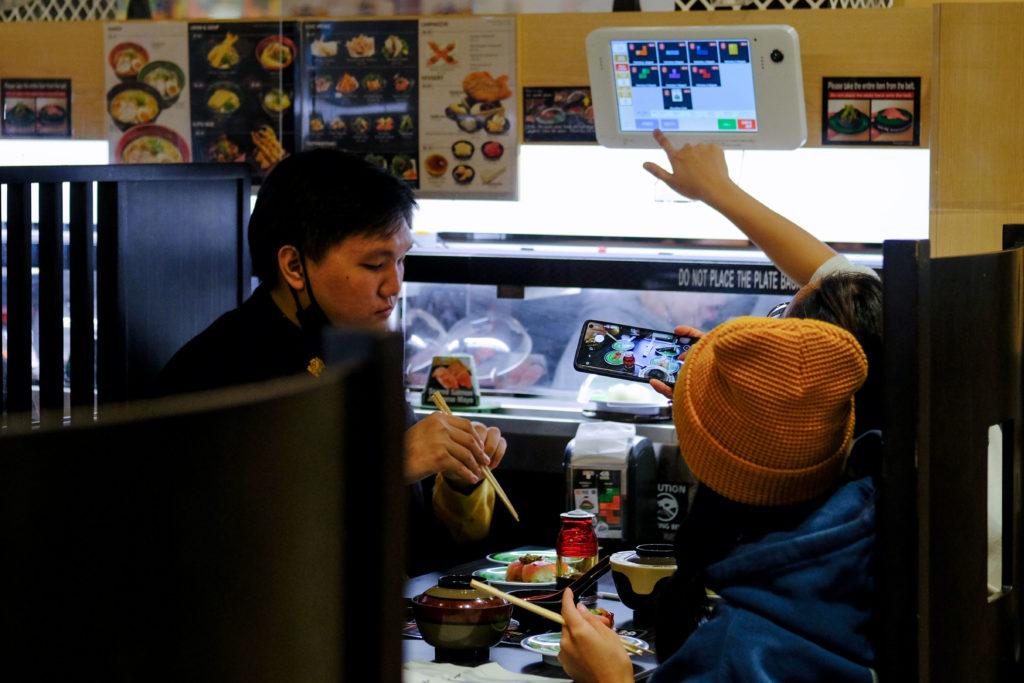Interactive Asian restaurants like Chinese hot pot or Korean barbecue may be new to the American lexicon, but these cuisines have histories dating back thousands of years.
From do-it-yourself dining experiences like Japanese shabu-shabu to efficient conveyor-belt sushi, you may be wondering where you can try these traditional dishes around the DMV. We researched some of the best spots to find these culturally steeped establishments around D.C. and what you can expect while there.
Here is a brief history of each cuisine and where you can taste it yourself:
Chinese hot pot
Although there are similar cuisines in other Asian countries, China is typically regarded as the home of hot pot. The Chinese word for hot pot – huǒguō – directly translates to “fire pot.”
A traditional hot pot meal involves a large bowl of broth that comes in a variety of flavors, like spicy Sichuan or ginger and scallion, that is placed in the center of the table and heated by induction or flame. Using chopsticks, diners submerge various ingredients into the boiling broth to quickly cook before dipping in a sauce and eating.
Ingredients submerged in the broth can vary greatly, including vegetables like onions, mushrooms or bok choy, thinly sliced meats like beef, pork or lamb, and noodles.
Diners can make their own concoction of dipping sauces from ingredients provided by the restaurant like soy sauce, sesame oil, vinegar and crushed chilis.
It’s commonly believed that this traditional way of cooking came from Mongol warriors who camped outside and ate dinner circled around a pot over the fire, which was helpful to keep warm and get everyone fed. Today, the tradition is carried on as quality time to sit with friends or family and share food while eating slowly.
You don’t have to travel far from Foggy Bottom to try authentic hot pot. Hot Pot City, located in Rockville, Md., serves Chongqing style hot pot known for its spicy Sichuan pepper broth. Supreme Hot Pot in Arlington also offers a full menu of traditional hot pot items, and Urban Hot Pot just opened a new location in Merrifield, Va.
Japanese shabu-shabu
Shabu-shabu is the Japanese take on Chinese hot pot. Similar to hot pot, shabu-shabu is served with beef and vegetables cooked in a dashi broth at the table. The meal also comes with its own set of dipping sauces and rice on the side.
The name ‘shabu-shabu’ translates to the onomatopoeic words ‘swish-swish.’
This style of hot pot arrived late to Japan in 1946 just after World War II. The backstory stands that a Japanese doctor was sent to Beijing as an army surgeon during the war where he tried Mongolian hot pot. He later lived in Kyoto where he introduced the dish to a chef at one of his favorite restaurants.
To try shabu-shabu near campus, head to Shabu Plus located in Adams Morgan. The restaurant describes its food as an “updated version of traditional Japanese Hot Pot with top grade meats, organic poultry and sustainable seafood.” If you’re willing to make the trek to Annandale, Va., Omy Hot Pot & Bar also serves Shabu-Shabu-style hot pot in a cozy and relaxed atmosphere. Gyu Shige offers a variety of hot pot dishes in addition to a full sushi menu in Merrifield, Va.
Korean BBQ
Korean barbecue is another trendy Asian cuisine that has entered American popular culture, but its origins can be traced back to the Maek, a nomadic group of people from Central Asia as early as 37 B.C.
The group relied on pre-seasoned meats that they carried with them while they traveled, developing a faster food prep technique that was novel to most of Northeast Asia.
Korean barbecue is made up of two important elements: banchan, which means “side dishes” like kimchi or seasoned cucumbers, and grilled meats like chicken, pork or beef. You cook the meat yourself over a small grill in the center of the table, turning, flipping and cutting it into bite-sized pieces.
One Korean barbecue classic is bulgogi, meaning “fire meat,” made from thinly sliced beef marinated in a sweet and savory sauce.
Luckily, the D.C. area has plenty of spots to try this dining experience. Head to Iron Age in Columbia Heights for the full DIY Korean barbecue experience. Or venture a little further to one of Honey Pig BBQ’s locations in Annandale, Va. or Rockville, Md. For a more lively dining experience, Gogi Yogi in Shaw offers all-you-can-eat barbecue and fun drinks like soju slushies.
Conveyor-belt sushi
Conveyor-belt sushi, or kaiten-sushi, is a worldwide phenomenon that you’ll enjoy for its efficiency and entertaining style.
The history of conveyor-belt sushi began in 1947 when Osaka restaurateur, Yoshiaki Shiraishi, visited an Asahi beer factory and observed the bottles floating across the filling floor on a conveyor belt. Shiraishi spent years refining his own conveyor, and in 1958, he opened Mawaru Genroku, the world’s first kaiten-sushi restaurant.
At most kaiten-sushi restaurants, customers can place individual orders with the sushi chef or via a tablet. Your food then arrives to you on the conveyor-belt, and the tab is calculated by an automatic count of your plates once you finish and place them in a dish slot at your table. Some chains even use RFID tags embedded in each plate and electronic wands to add up the bill.
Kura Sushi in Chinatown offers the full experience. At Kura Sushi, guests can choose to either order specific sushi plates through a table tablet or pick up any of the sushi plates that are continuously revolving around the conveyor belt.








